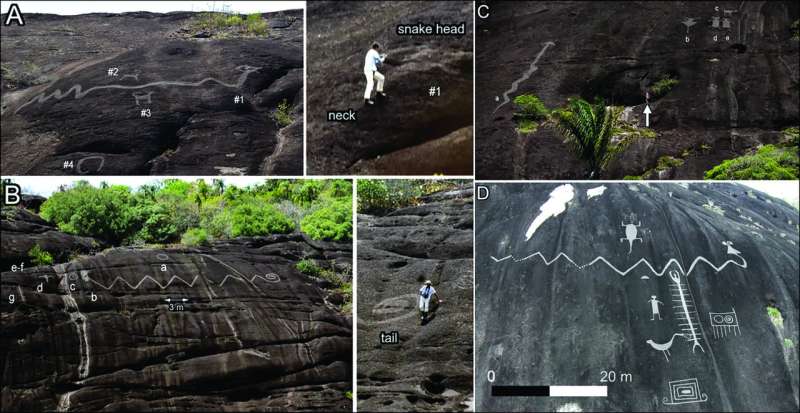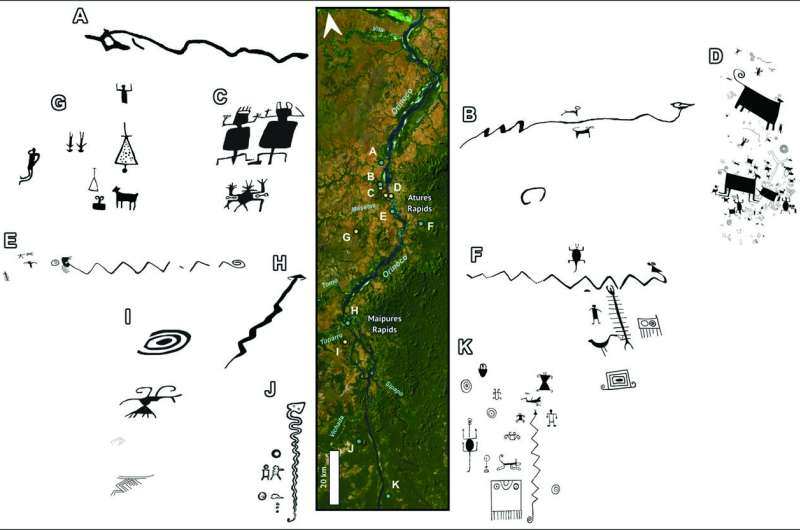This article has been reviewed according to Science X's editorial process and policies. Editors have highlighted the following attributes while ensuring the content's credibility:
fact-checked
peer-reviewed publication
trusted source
proofread
Enormous rock engravings may be prehistoric territorial markers, suggest archaeologists

Archaeologists have mapped 14 sites featuring the world's largest monumental engravings, proposing that they were created to signal the territorial boundaries of the prehistoric inhabitants.
The engravings, located on rock faces along the Upper and Middle Orinoco River, are extensive, with the largest measuring more than 40m long. The team believe this is the largest single rock engraving recorded anywhere in the world.
"These monumental sites are truly big, impressive sites, which we believe were meant to be seen from some distance away," says lead author of the research and Senior Lecturer in Archaeological Environmental Modeling at Bournemouth University, Dr. Philip Riris.
In order to determine the purpose of these engravings, Dr. Riris and a team of researchers from Bournemouth University (UK), University College London (UK) and Universidad de Los Andes (Colombia) worked with local guides to map them using drone photography. Their results are published in the journal Antiquity.
While some of the sites were already known, the team have discovered several more. Similar motifs used on pottery found in the area indicate that they were created at least 2,000 years ago, and possibly much earlier.
Many of the largest engravings are of snakes, believed to be boa constrictors or anacondas, which play an important role in the myths and beliefs of the local Indigenous population.

"We know that anacondas and boas are associated with not just the creator deity of some of the Indigenous groups in the region, but that they are also seen as lethal beings that can kill people and large animals," says Dr. Riris. "We believe the engravings could have been used by prehistoric groups as a way to mark territory, letting people know that this is where they live and that appropriate behavior is expected."
Dr. José Oliver, Reader in Latin American Archaeology at UCL Institute of Archaeology, adds, "The engravings are mainly concentrated along a stretch of the Orinoco River called the Atures Rapids, which would have been an important prehistoric trade and travel route. This means it would have been a key point of contact, and so making your mark could have been all the more important—marking out your local identity and letting visitors know that you are here."
The engravings would therefore have been intended to communicate with a wide range of people from diverse cultural backgrounds.
"Snakes are generally interpreted as quite threatening, so where the rock art is located could be a signal that these are places where you need to mind your manners," states Dr. Riris.
The research team conclude that it is vital that these monumental rock art sites are protected to ensure their preservation and continued study, with the Indigenous peoples of the Orinoco region central to this process.
"We've registered these sites with the Colombian and Venezuelan national heritage bodies as a matter of course, but some of the communities around it feel a very strong connection to the rock art," says Dr. Natalia Lozada Mendieta from Universidad de Los Andes. "Moving forward, we believe they are likely to be the best custodians."
More information: Philip Riris et al, Monumental snake engravings of the Orinoco River, Antiquity (2024). DOI: 10.15184/aqy.2024.55
Journal information: Antiquity
Provided by Antiquity





















